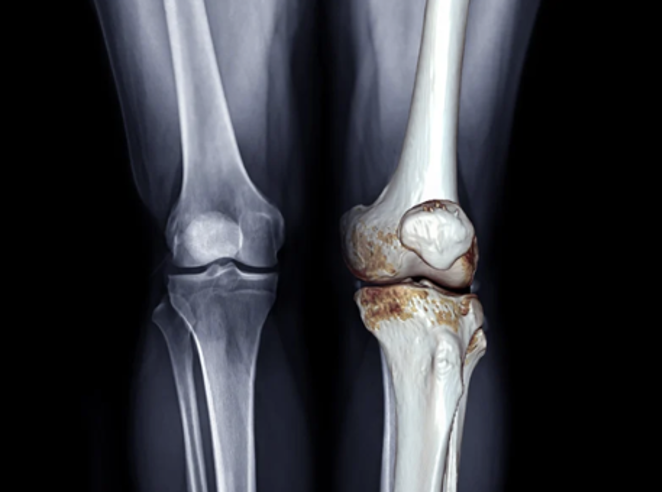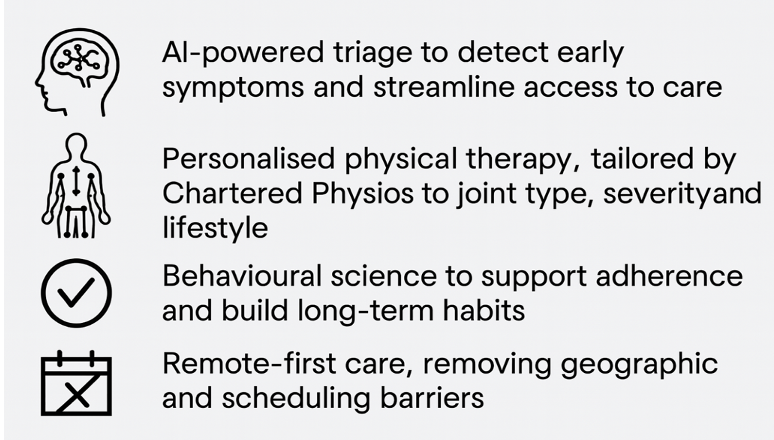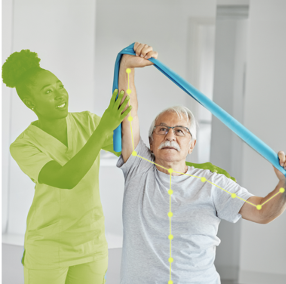“Prevention is better than cure” isn’t just a proverb – it’s a business imperative in 2025.
Osteoarthritis (OA) affects over 8.5 million people in the UK and is a leading cause of pain and disability among working adults. Far from being a simple matter of “wear and tear,” OA is a complex joint disorder that impacts not only individuals, but also the organisations they work for.
As the workforce ages and the burden of musculoskeletal (MSK) conditions rises, OA is fast becoming a critical issue for HR leaders focused on wellbeing, productivity, and long-term workforce sustainability. In the UK, around 1 in 4 women over 45 are diagnosed with OA, compared to about 1 in 5 men. Women are 2–3 times more likely to develop knee OA than men.
For a clinical deep dive into OA and its workplace implications, watch a 20-minute webinar led by our MSK Director, Dr Nick Fuggle: https://vimeo.com/manage/videos/1099639413
Why OA Matters for HR Strategy
Osteoarthritis disproportionately affects adults aged 45 and above; a demographic that makes up a growing portion of today’s workforce. In fact:
- MSK conditions, including OA, account for over 30% of all workplace sickness absence in the UK
- The economic cost of MSK disorders to UK employers is estimated at £3.5 billion annually
- OA is a leading contributor to early retirement and long-term disability
Supporting employees with early-stage symptoms can prevent functional decline, reduce costly absences, and preserve the contribution of experienced staff!
The Science Behind Osteoarthritis: Beyond Wear and Tear
Osteoarthritis is a long-term condition where the joints become stiff, painful, and less flexible over time. It happens when the protective cartilage that cushions the joints gradually wears away, causing bones to rub against each other. This can lead to:

- Joint pain and tenderness
- Stiffness, especially in the morning or after inactivity
- Swelling around the joint
- A crackling or grinding sensation during movement
- Reduced range of motion, making everyday tasks harder
It most commonly affects the knees, hips, hands, and lower back, and tends to worsen gradually without the right intervention.
It’s often seen as a “normal part of ageing,” but for many people, it becomes a daily struggle that affects how they move, work, and feel. OA doesn’t just impact physical jobs office-based employees may struggle with sitting for long periods or lose mobility over time due to inactivity.
The result? Employees are still turning up but with more pain, slower movement, and less energy. That’s presenteeism, and it’s often harder to spot than absence.
Recognising OA in Your Workforce
From an organisational perspective, OA rarely presents with a diagnosis label. Instead, it shows up in patterns of behaviour that affect day-to-day work, such as:
- Employees struggling with prolonged standing, walking, or stair use
- Reports of joint stiffness, especially in the morning or after long periods of inactivity
- Increased absenteeism or presenteeism due to musculoskeletal pain
- Withdrawal from physical tasks or reduced participation in team activities
- Subtle mobility changes, gait alterations, or reliance on support (e.g., leaning on desks)
These signs often go unreported not due to lack of impact, but due to employees quietly “getting on with it.” For HR teams, this represents a hidden burden that can erode performance and wellbeing over time.
How DocHQ Physio Transforms OA Care in the Workplace
At DocHQ, we’ve reimagined physiotherapy for modern working life. Our digital MSK platform blends clinical accuracy with user-friendly technology to provide early, effective, and scalable care for employees with OA and other joint conditions.
Our approach includes:

Crucially, our platform is designed to identify red flags and escalate cases that need onward referral, ensuring safety and clinical oversight.
Conclusion
Osteoarthritis may not always be visible, but its impact on your workforce is very real.
By recognising the signs early and offering accessible, tailored support, HR leaders can reduce avoidable absence, improve employee wellbeing, and create a culture where people feel empowered to manage their health.
With the right tools in place, joint pain doesn’t have to mean lost productivity and your team doesn’t have to push through in silence.
Find out how we can support your team

To learn more about the solutions behind effective OA care in the workplace,
Book a Free Demo today: joe.stewart@dochq.co.uk



